



the two cultures: a discussion Katrin Newger Supervisor: Christoph Jansen M.Sc. and Dipl.-Math. Georg Schollmeyer June 27, 2015 Department of Statistics, LMU Munich
table of contents 1. The Two Cultures 2. Breiman’s Argument 3. Discussion 4. Personal Impressions and Conclusion 1
the two cultures
nature 3
data model Assumptions: ∙ Stochastic model ∙ Distribution of residuals ∙ Further model specific assumptions 4
algorithmic model Goal: 5 Function f ( x ) that minimizes loss L ( Y , f ( x ))
examples for algorithmic models Methods: ∙ Support vector machines ∙ Random forests ∙ Artificial neural networks ∙ … 6
breiman’s argument
the data model—too simple a picture ∙ Critical model assumptions ∙ Conclusions about model, not about nature 8 ∙ Wrong model → wrong conclusions about nature ∙ Algorithmic models only assume iid. variables
the model’s fit (1/3) “A few decades ago (…) the belief in data models was such that even simple precautions such as residual analysis or goodness-of-fit tests were not used” (Breiman 2001, p. 199) 9
the model’s fit (2/3) ∙ Necessity of checking the model’s fit ∙ Discussion of the fit is superficial ∙ Most popular: goodness-of-fit tests, residual analysis 10
the model’s fit (3/3) Goodness-of-Fit Tests ∙ Not useful if direction of alternative not precisely defined ∙ Extreme discrepancy to the data is needed Residual Analysis ∙ For more than four dimensions: interactions between variables Algorithmic modeling: cross-validation is standard procedure 11 → manipulation of residual plots
multiplicity of models ∙ Neither model is able to trump ∙ Further problem: variable selection based on model 12 ∙ Different models → different assumptions → different conclusions ∙ Algorithmic modeling: only iid. assumption
inference ∙ Testing on 5% level is arbitrary (“suspect way to arrive at conclusions”, Breiman 2001, p. 203) 13 ∙ Common assumption: n → ∞ never fulfilled ∙ Algorithmic modeling: no inference
curse of dimensionality ∙ Data models become too complex ∙ Common procedure: reducing dimensionality (e.g. principal 14 ∙ Originally: n ≫ p ↔ nowadays: p ≫ n component analysis) → loss of information ∙ Algorithmic modeling: the more variables the more information
prediction ∙ Prediction is more important than interpretation—always ∙ If prediction is bad, how can interpretation be good? 15 ∙ Breiman’s experience: algorithmic models are best predictors
breiman’s conclusion ∙ Everyone’s choice which model is best “The best solution could be an algorithmic model, or maybe a data model, or maybe a combination” (Breiman 2001, p. 206) ∙ Openness for new methods 16
discussion
bias–variance trade-off “[The Bias] has to be lurking somewhere inside the theory” (Brad Efron, in Breiman 2001, p. 219) ∙ In algorithmic modeling, small variance at cost of bias? ∙ Breiman avoids answer 18
multiplicity of models ∙ Does not concern prediction ∙ Just as well in algorithmic models ∙ Main difference between models: distribution ∙ Breiman manipulates reader 19
model assumptions ∙ Why not use known information (e.g. distribution)? ∙ Critical iid. assumption in data models and algorithmic models ∙ Alternatives if iid. assumption is violated? 20
prediction versus interpretability ∙ Rivaling abilities of models ∙ Often interpretation required ∙ Prediction sometimes indirectly related to data “The whole point of science is to open up black boxes, under- stand their insides, and build better boxes for the purposes of mankind” (Brad Efron, in Breiman 2001, p. 219) 21
personal impressions and con- clusion
references Leo Breiman Statistical Modeling: The Two Cultures. Statistical Science 16 (3), 2001: 199–231. T. Hastie, R. Tibshirani and J. Friedman The Elements of Statistical Lernaning. Data Mining, Inference and Prediction. Heidelberg: Springer, 2009. 23
questions and discussion 24
Recommend
More recommend